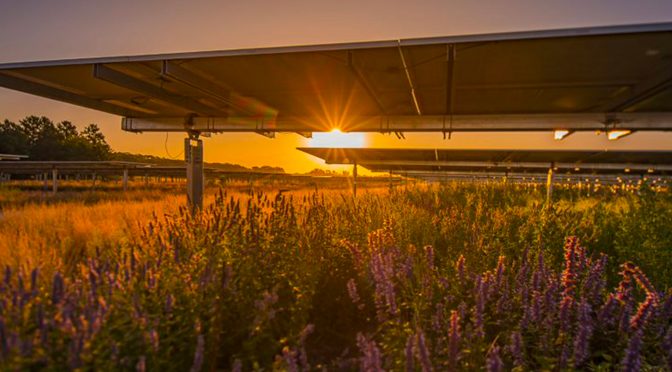A new experimental program in Europe, to find the best farming and animal husbandry solutions to integrate with large photovoltaic plants, in order to foster sustainable land management.
Photovoltaic plants constructed in rural areas do not necessarily need to take away precious land from farming activities. Indeed, energy efficiency can be combined with the sustainable use of land and the protection of biodiversity. To achieve precisely this, Enel Green Power has launched an ambitious program of full-scale demonstrations simultaneously in Spain, Italy and Greece to find ways to integrate solar energy production with arable and pastoral farming activities.
By taking advantage of the Open Innovability approach, which aims to seek out the best ideas and resources also outside of the company, EGP has teamed up with partners from the worlds of research and industry, startups and also non-profits. The aim is to identify arable and pastoral farming activities that can coexist with solar power plants without having to significantly modify the layout of the plant, thereby containing costs and maintain competitiveness. For example, the unencumbered space between rows of trackers (i.e. the devices that change the direction of the panels in order to capture more solar energy) can be used for planting crops as long as they do not risk shading the panels.
The real innovation challenge is the need to come up with an optimal model of integrated management for both the activities tied to the photovoltaic plant’s operation and maintenance and those related to farming – all without altering the layout of the plant and also occupying the valuable land beneath the panels, selecting plants that do not grow beyond a specific height and are well suited to local environmental conditions. The experimental projects include various tests in parallel on different types of solar plants, both on greenfield sites (previously not used for agricultural production) and Futur-e sites (i.e. sites of decommissioned power plants that are being repurposed).
“These experiments will produce a huge amount of data that will be compiled in an Atlas to support future decisions, enabling new plants to select the best farming solutions and related business models based on the solar technology, the local climate and the analyses of the social, economic and environmental context,” explains Miriam Di Blasi, Head of Environment and Impacts Mitigation Innovation.
The project is being made possible thanks to partnerships initiated with universities and research institutes, industrial companies, engineering firms, non-profits and startups. In this way, very specific and complementary fields of expertise have been brought onboard to ensure a global approach in the definition of the experimental program. Also factors that are external to the selected sites are being taken into consideration, and the aim is to promote a diversified use of land, improve ecosystemic services and create shared value for the local community through an approach that engages a multitude of interested parties.
In the initial planning phase, nine demonstration sites in Europe were launched simultaneously (two in Greece, five in Spain, two in Italy) to define the solutions. In January of this year the tests began.
At the Pezouliotika photovoltaic plant in Greece, the cultivation of aromatic herbs, flowers and mixes of plants capable of attracting pollinating species will be tested, and nests will be installed to improve the habitat of some bird species. Meanwhile in Kourtesi, growing medicinal herbs for the preparation of animal feeds will be experimented with, within a circular economy framework. The option of integrating chicken rearing activities within the solar plant is also being studied.
In Spain, at the Totana, Valdecaballeros and Las Corchas photovoltaic plants, different species – including artichokes, broccoli, zucchinis, eggplants, forage crops for animals, peppers, pitaya (a tropical fruit rich in iron and vitamin E), medicinal and aromatic herbs, cilantro, lavender and flowers to attract pollinators (not only bees but also bumblebees, butterflies and other insects) – are being tested. In particular, specific species of herbs and legumes that can improve the habitat for birds were sown at the site in Totana.
In Italy, at the Bastardo thermoelectric plant currently being decommissioned, different species of herbs and forage crops, cucurbits and combinations of plants that attract pollinators will be tested. At the Montalto di Castro thermoelectric plant, also being decommissioned, the experiments will focus on mint, legumes, asparagus and saffron. In addition to integrating bee colonies, the project is also evaluating whether it will be possible to rear Verde Leprino rabbits – a variety that is typical of the Viterbo area.


